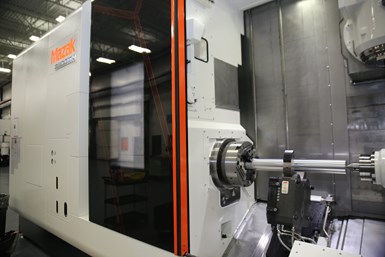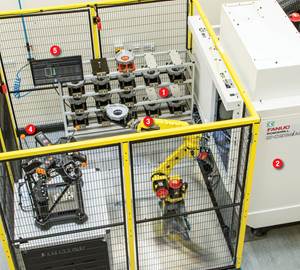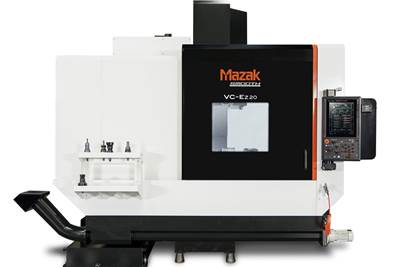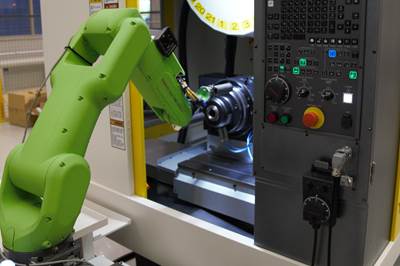The Case for Automatic Door Operation
Automatic door systems for stand-alone machine tools require periodic inspection and maintenance, but excel in environments with automation capability or frequent door use.
Share



 Machine builders such as Mazak devote considerable engineering to the design and construction of the sliding doors on a machine enclosure such as seen here on an Integrex e670H. The black strip running from top to bottom at the edge of the door (visible between the orange trim that enhances visibility when in the open position) is the pressure safety switch permitting a machine cycle to start only when the door is fully closed.
Machine builders such as Mazak devote considerable engineering to the design and construction of the sliding doors on a machine enclosure such as seen here on an Integrex e670H. The black strip running from top to bottom at the edge of the door (visible between the orange trim that enhances visibility when in the open position) is the pressure safety switch permitting a machine cycle to start only when the door is fully closed.Ever since machine tools began to be delivered in full sheet metal enclosures (a trend dating to the late 1960s) there has been a door to open and close — you open it to access the work zone and close it to keep coolant and chips contained during machining. These are two extra steps for the production process, representing additional chores for the operator or additional programmed operations in an automated configuration.
Today, most machine tool builders offer an optional automated door opening and closing feature on stand-alone machine tools. It is another item for the machine tool buyer to consider when ordering a new CNC machining or turning center.
In a recent conversation with machine tool builder Mazak related to standard and optional machine features and accessories, I asked which of the many machine options for automation was the most overlooked or underappreciated. I was surprised to hear that automatic door opening and closing clearly was the answer.
The feature is often overlooked simply because it is not usually on the list of extras that shops and plants are looking for. A probing system, high-pressure coolant system, expanded tool magazine, high-speed spindle or other feature more closely related to operational efficiencies is more likely to get attention. For many buyers, opening and closing the enclosure door falls outside typical cycle time calculations. As a result, this feature often gets short shrift during negotiations for new machine purchases. This may be unfortunate because installing a door system in the field later on has drawbacks in cost and disruption.
To understand better, I discussed this topic with Jared Leick, machining center product manager at Mazak’s headquarters in Florence, Kentucky. He had much to tell me. The gist of these discussions can be summed up rather neatly: Auto door systems are definitely worth thoughtful and informed consideration. This feature will be a good choice for some shops, but less so for others.
“Entry-Level” Automation
Typically, machine tool enclosure doors open at the front of the machine for operator access to the machining zone (side or rear doors are generally reserved for automatic accessories such as pallet changers or robotic systems). Roller bearings riding in tracks, which may be attached at the top as well as the bottom of the door, reduce resistance to make the door easy to move. Automatic systems require a servo-driven mechanism or an air cylinder for actuation. According to Leick, servo-driven systems are more flexible, but more costly. Air cylinders are simpler and more economical.
Either style must be sized for the weight and travel of the door. For enclosures with double doors that close from opposite sides, each door must be equipped with a separate system. Generally, air cylinders fully open or close the door once the operator holds down two palm buttons on the control panel. Stopping the door somewhere in the middle is not usually possible. For servo-driven systems, the operator pushes a soft button on the control panel to trigger door opening or closing. Pushing the button again stops the door at any point in its travel.
Both types of systems have a pressure-sensitive safety switch to stop the door if it meets resistance. Large, heavy doors with more momentum in motion may have a light curtain or scanner to stop the door if interrupted.
Leick says that a factory-installed door system will represent about 1 to 3 percent of the total cost of the machine, but some customized systems can run higher. A shop wishing to install a door system once the machine is in its facility can expect the cost to be roughly half again what it would have been as an original purchase item. In-the-field installation typically takes a machine out of production for two days, depending on the complexity of the job. Leick notes that some machines may require an especially fabricated cover to protect the system components, which may complicate or lengthen installation.
Leick reports that requests for field installation have been rising in the last 2 to 3 years, a trend that seems to indicate that buyers should give the feature more attention during the initial purchase cycle. Growing interest in automatic loading and unloading systems, he says, is one reason for the uptick in post-purchase installations.
Why to Buy
Factors influencing buyers to opt for auto door opening and closing include lot size, cycle times, type of work and ergonomics, Leick says. “If the door must be opened and closed frequently, automated operation has more value and appeal,” he explains. For example, a shop running smaller batches of parts with shorter cycle times is likely to judge this feature a significant timesaver and convenience. Likewise, if the operator is frequently checking inserts, adjusting fixtures, clearing chips or spot-checking features with a micrometer, push-button door operation can be a real plus. Prototype work is a scenario in which these systems seem to fit well.
“This is an option that creates options,” Leick says.
An air-cylinder system may be a good choice for shops in this situation because of the system’s simplicity and lower cost. However, shops considering adding greater automation or moving the machine into a cell may choose a servo-driven system because this system type is automation-ready and easily interfaces with the cell controller. The flexibility of servo systems is a clear advantage. Users can also set up servo systems to operate when signaled by the control system, with automations such as closing when the cycle starts and opening when the cycle stops.
Why Not to Buy
Shops in other situations may be compelled to decline this option. As Leick observes, long production runs and long cycle times obviously make the door a less-important concern. Likewise, operators may find it simpler and easier to work the door manually when necessary.
Auto door systems are robust and reliable, he says, but do require periodic inspection and routine maintenance (usually minor). Like all electrical or mechanical systems, failures can occur. Accidents that might jam or misalign a door are also likely to damage the opening/closing system. That said, Leick reports that “we’ve seen few repairs, so the track record for these systems is good.”
Common problems on air cylinder systems include bearing wear, cylinder seal failure or air line leakage. On servo-driven systems, connector or switch failures can occur.
A comment Leick hears from some machine buyers who ultimately turn down this option is simply this: “It’s just one more thing.”
 The factory-installed servo-driven door system on this Mazak QT-350MY turning center is equipped with a ballscrew and sealed nut said to provide smooth, reliable operation in the automatic mode. Similar systems are designed for other turning, milling and multi-tasking machines in the company’s line-up.
The factory-installed servo-driven door system on this Mazak QT-350MY turning center is equipped with a ballscrew and sealed nut said to provide smooth, reliable operation in the automatic mode. Similar systems are designed for other turning, milling and multi-tasking machines in the company’s line-up.Automated Door Systems’ Strengths Over Robots
Although it is entirely possible to program the robotic arm in an automated cell to open and close the door of a machine tool in between loading and unloading workpieces, Mazak’s automation experts do not recommend it.
For one reason, the door handles on a machine enclosure are designed ergonomically for the grip and strength of a human arm. The gripper of a robot is likely to mar or damage an unmodified enclosure handle. Likewise, the natural motion of a human hand and arm lacks the somewhat slam-bang action that may be inherent in the mechanical stroke of a robotic arm. Over time, the robotic action tends to cause excessive wear of the door's tracks and may pull the door off the rails.
For another reason, tasking the robot with opening and closing the door adds non-productive time to a machining process, whereas a servo-driven door mechanism can be set to function simultaneously in coordination with other programmed operations of the robot.
"In the long run, servo-driven door operation is both more efficient and more economical," says one Mazak integration specialist, noting that shops thinking ahead to automation are best advised to opt for the factory-installed door system when purchasing the machine.
A Gentle Recommendation
Leick believes that auto door systems should get a positive nudge for most buyers of standalone machines. The trend to automation and integration tilts in favor of the system, he says.
The best recommendation he can offer is to put the option on the purchase checklist and consider it carefully. Think of current and future needs and possibilities. Make an informed decision.
“This is an option that creates options,” he concludes, and therefore is not one to be neglected.
Related Content
Revolutionizing Production: How Smart Hydraulics Drive 24/7 Manufacturing Excellence
All World Machinery Supply helps a firearms manufacturer up its game and improve and increase output.
Read More5 Stages of a Closed-Loop CNC Machining Cell
Controlling variability in a closed-loop manufacturing process requires inspection data collected before, during and immediately after machining — and a means to act on that data in real time. Here’s one system that accomplishes this.
Read MoreEmbracing Automation: Strategies for Small to Medium-Sized Machine Shops
Business drivers for automating to help navigate workforce challenges and boost profitability.
Read MoreAddressing Manufacturing Challenges with Automation
GrayMatter Robotics’ Physical AI robotic cells for manufacturing offer immediate impact and results.
Read MoreRead Next
Cutting Tool Technology Aids Lights-Out Machining Applications
These features can help improve cutting tool stability, standardize cutting performance and extend tool life, enabling shops to confidently run unattended shifts.
Read MoreMazak Takes Entry-Level Machine Tools to New Heights
A new machine series aims to address the immediate and longer term requirements of job shops by lowering cost barriers to acquiring manufacturing technology without foregoing capability or compromising performance.
Read MoreAvoiding a Failed Automation Integration
New features that simplify robot use have blurred the lines between tasks that shops can automate independently from those that will require the support of an integrator. Here’s what shops should keep in mind to avoid a costly failed integration.
Read More




























